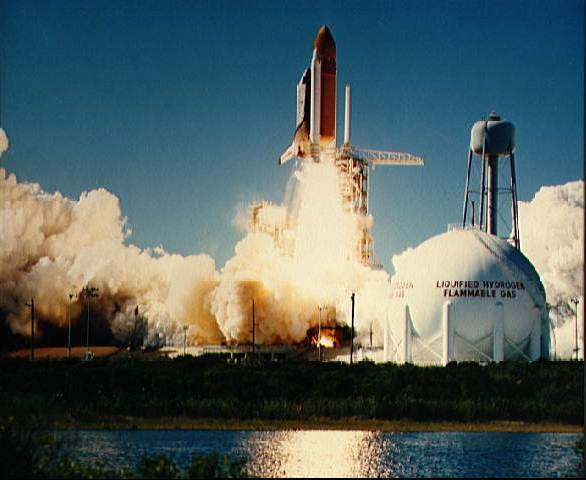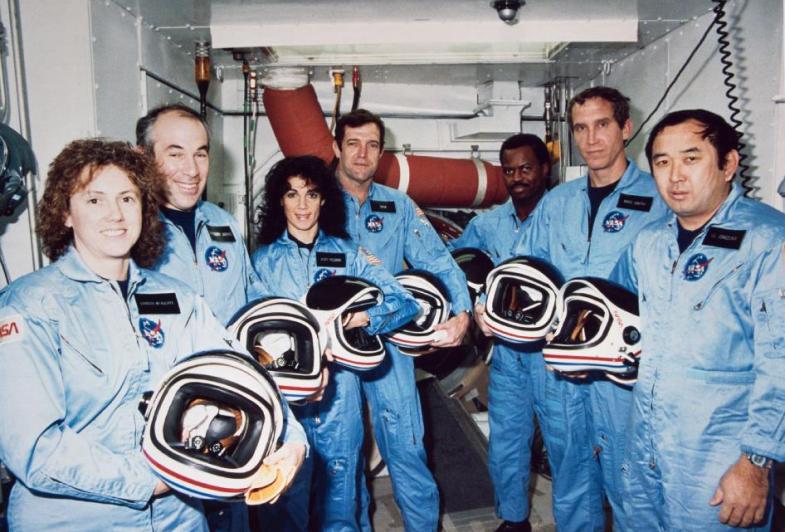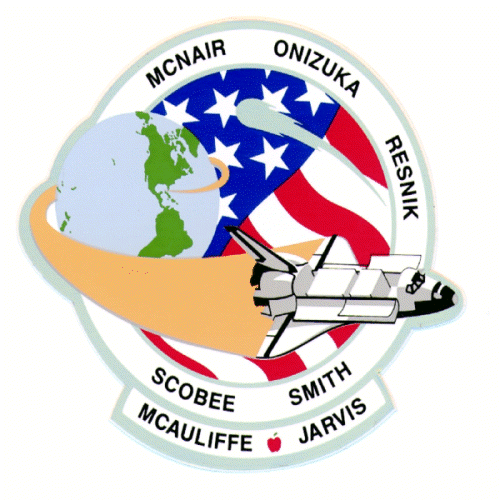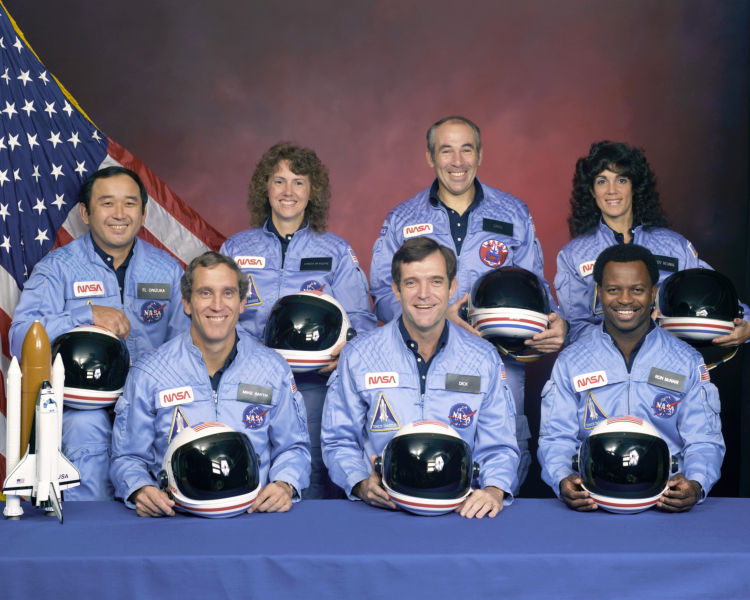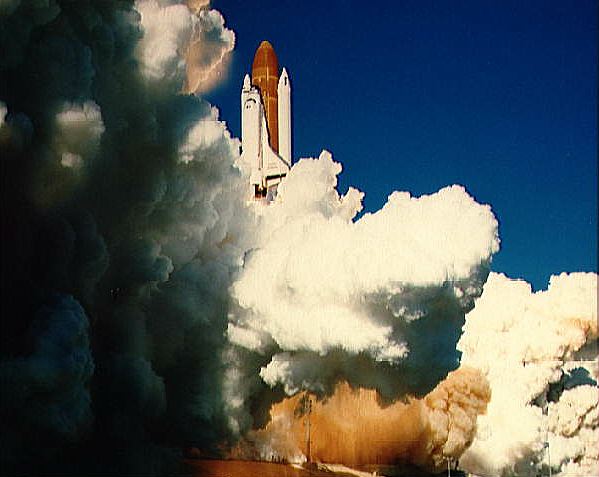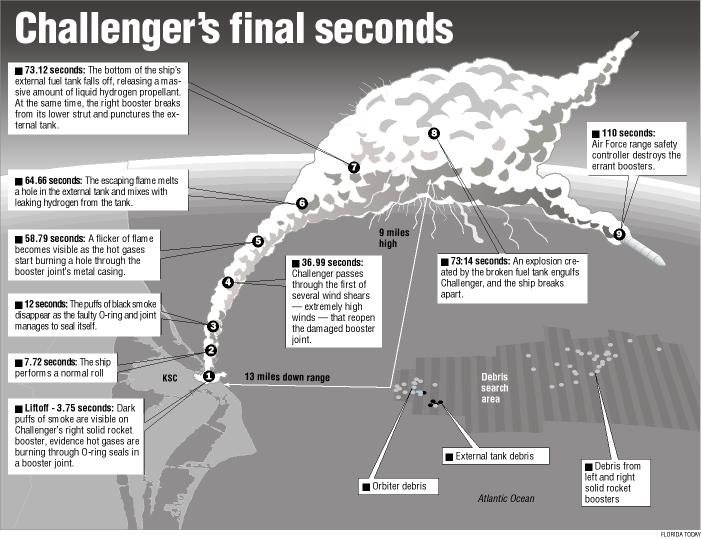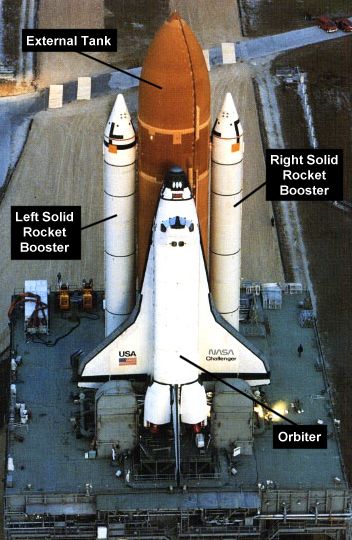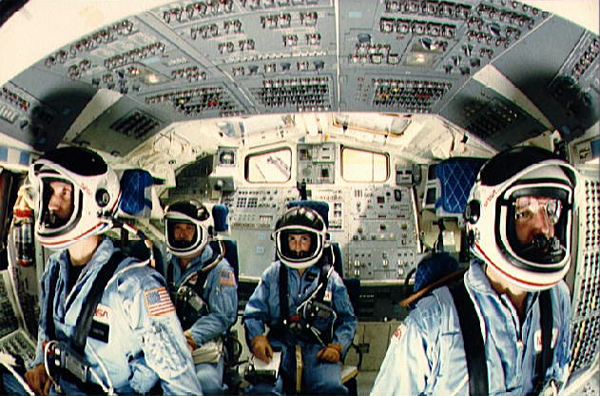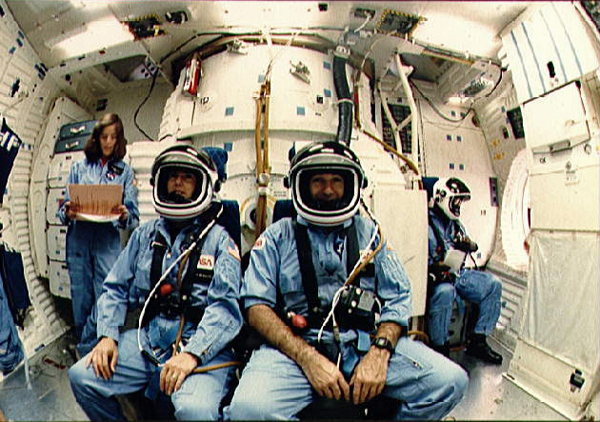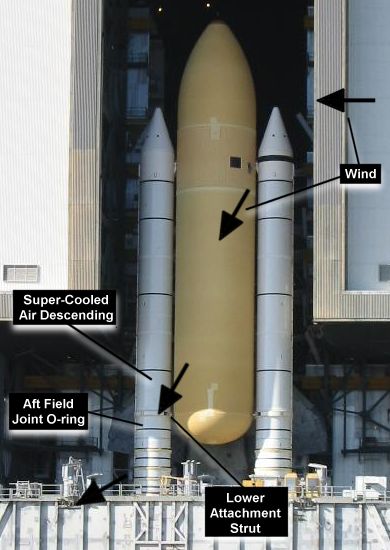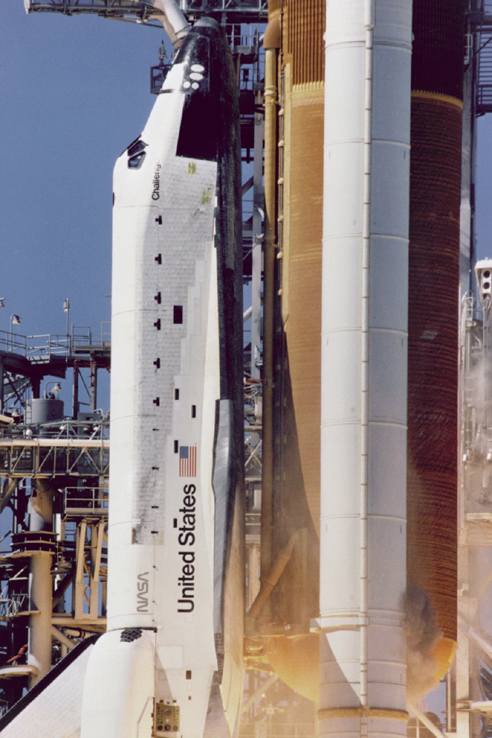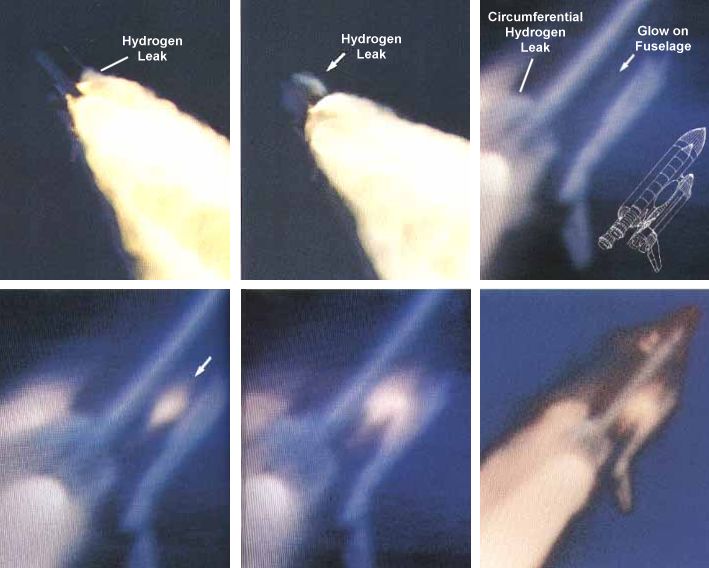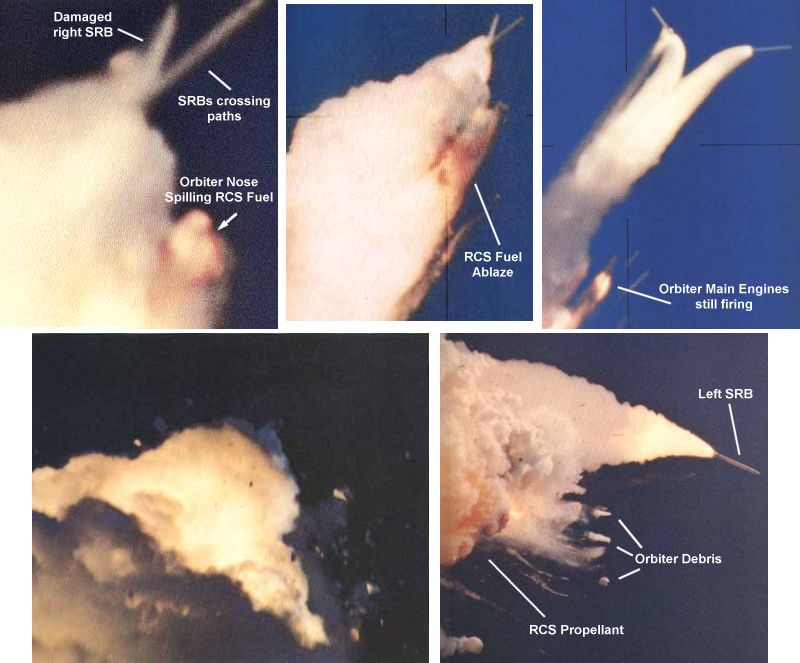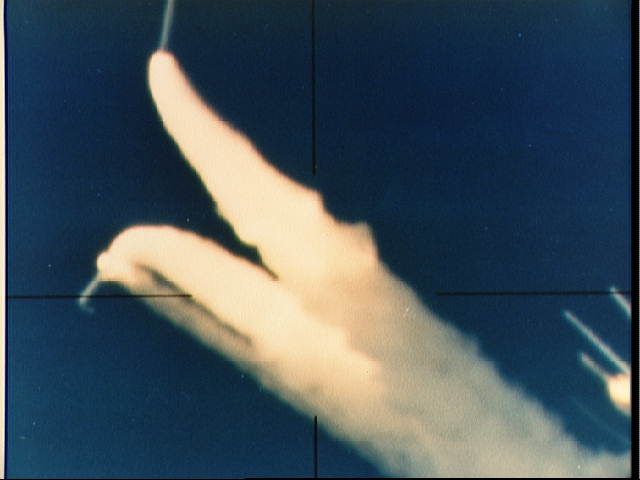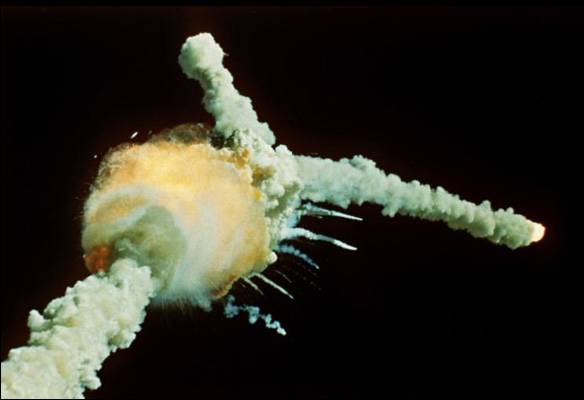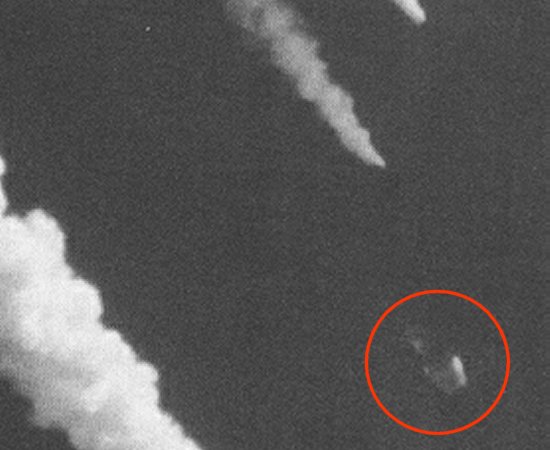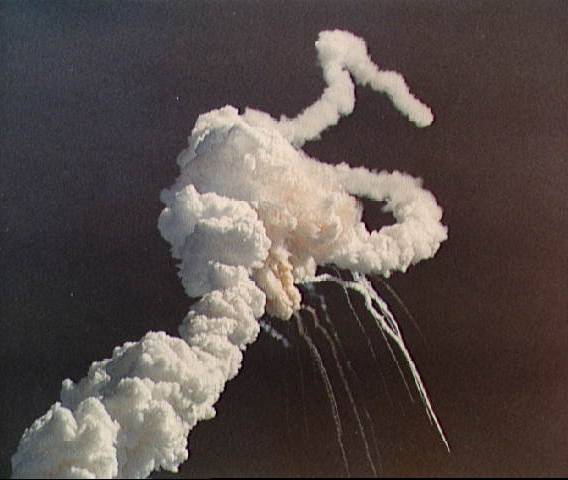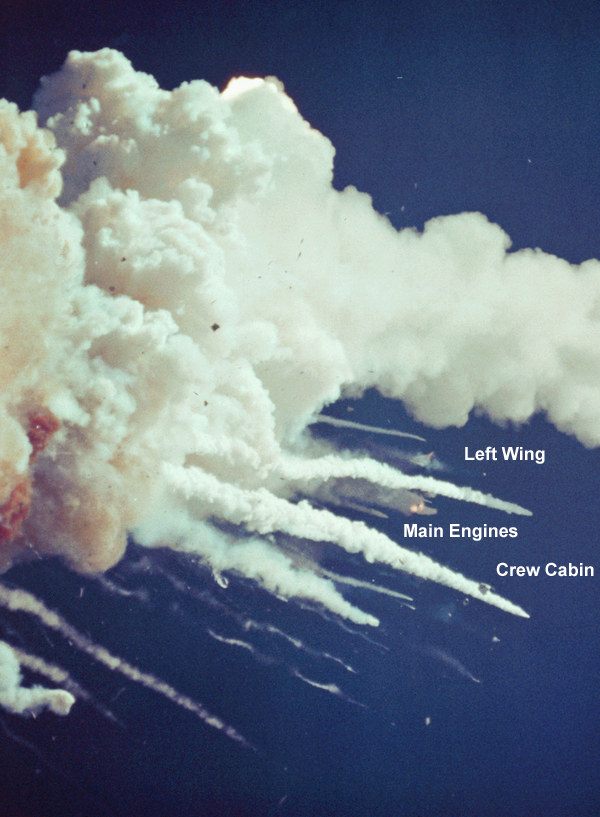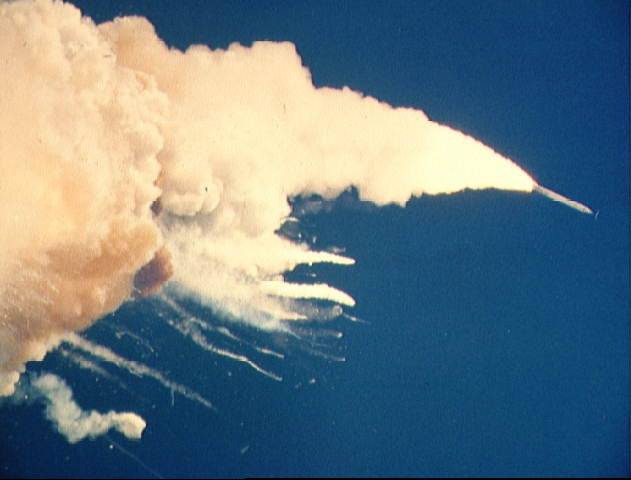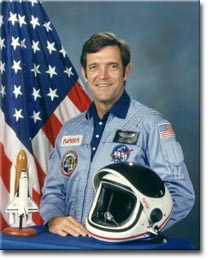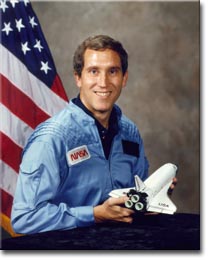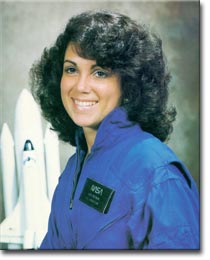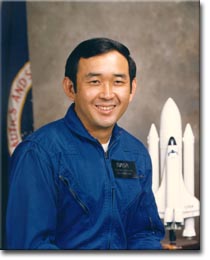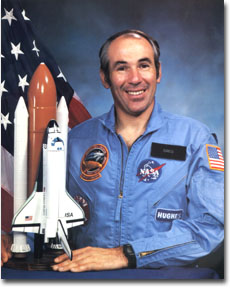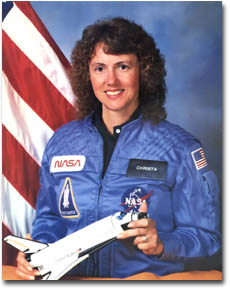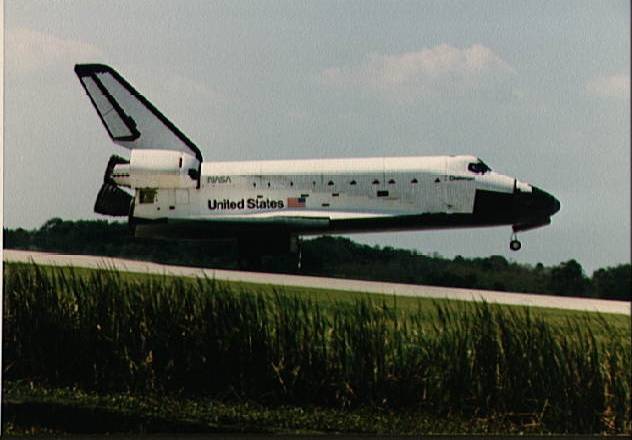
|
||||||||||||
|
|
|
Space Shuttle Challenger
Liftoff of the Shuttle Challenger STS 51-L On January 28, 1986,11:38:00 a.m. EST The Space Shuttle Challenger launched from the Kennedy Space Center. The seven-member crew was killed after a vehicle breakup which occurred 73 seconds after lift-off because of an O-ring seal failure in the booster system.
In this photo from Jan.
9, 1986, the Challenger crew takes a break during countdown training at NASA's
Kennedy Space Center. Left to right are Teacher-in-Space payload specialist
Sharon Christa McAuliffe; payload specialist Gregory Jarvis; and astronauts
Judith A. Resnik, mission specialist; Francis R. (Dick) Scobee, mission
commander; Ronald E. McNair, mission specialist; Mike J. Smith, pilot; and
Ellison S. Onizuka, mission specialist.
The five men and two women - including the first teacher in space - were just over a minute into their flight when the Challenger blew up.
President Ronald Reagan in an address to the nation described the tragedy as "a national loss".
The Challenger's flight, the 25th by a shuttle, had already been delayed because of bad weather. High winds, then icicles caused the launch to be postponed from 22 January.
STS-51-L INSIGNIA The STS-51-L crewmembers designed this insignia to represent their participation in NASA's mission aboard the Challenger, depicted launching from Florida and soaring into space to carry out a variety of goals. Among the prescribed duties of the five astronauts and two payload specialists will be observation and photography of Halley's Comet, back dropped against the U.S. flag in the insignia. Surnames of the crewmembers encircle the scene, with the payload specialists being recognized below. Surname of the first teacher in space, Sharon Christa McAuliffe, is followed by a symbolic apple.
The crew of Space Shuttle mission STS-51-L pose for their official portrait on November 15, 1985. In the back row from left to right: Ellison S. Onizuka, Sharon Christa McAuliffe, Greg Jarvis, and Judy Resnik. In the front row from left to right: Michael J. Smith, Dick Scobee, and Ron McNair. The photo is S85-44253 from the Johnson Space Center
PRESIDENTIAL COMMISSION on the Space Shuttle Challenger Accident-The Accident Flight of the Space Shuttle Challenger on Mission 51-L began at 11:38 a.m. Eastern Standard Time on January 28, 1986. It ended 73 seconds later in an explosive burn of hydrogen and oxygen propellants that destroyed the External Tank and exposed the Orbiter to severe aerodynamic loads that caused complete structural breakup. All seven crew members perished. The two Solid Rocket Boosters flew out of the fireball and were destroyed by the Air Force range safety officer 110 seconds after launch. The ambient air temperature at launch was 36 degrees Fahrenheit measured at ground level approximately 1,000 feet from the 51-L mission launch pad 39B. This temperature was 15 degrees colder than that of any previous launch. The following description of the flight events is based on visual examination and image enhancement of film from NASA operated cameras and telemetry data transmitted from the Space Shuttle to ground stations. The last telemetry data from the Challenger was received 73.618 seconds after launch. At 6.6 seconds before launch, the Challenger's liquid fueled main engines were ignited in sequence and run up to full thrust while the entire Shuttle structure was bolted to the launch pad. Thrust of the main engines bends the Shuttle assembly forward from the bolts anchoring it to the pad. When the Shuttle assembly springs back to the vertical, the Solid Rocket Boosters' restraining bolts are explosively released. During this prerelease "twang" motion, structural loads are stored in the assembled structure. These loads are released during the first few seconds of flight in a structural vibration mode at a frequency of about 3 cycles per second. The maximum structural loads on the aft field joints of the Solid Rocket Boosters occur during the "twang," exceeding even those of the maximum dynamic pressure period experienced later in flight. Just after liftoff at .678 seconds into the flight, photographic data show a strong puff of gray smoke was spurting from the vicinity of the aft field joint on the right Solid Rocket Booster. The two pad 39B cameras that would have recorded the precise location of the puff were inoperative. Computer graphic analysis of film from other cameras indicated the initial smoke came from the 270 to 310-degree sector of the circumference of the aft field joint of the right Solid Rocket Booster. This area of the solid booster faces the External Tank. The vaporized material streaming from the joint indicated there was not complete sealing action within the joint. Eight more distinctive puffs of increasingly blacker smoke were recorded between .836 and 2.500 seconds. The smoke appeared to puff upwards from the joint. While each smoke puff was being left behind by the upward flight of the Shuttle, the next fresh puff could be seen near the level of the joint. The multiple smoke puffs in this sequence occurred at about four times per second, approximating the frequency of the structural load dynamics and resultant joint flexing. Computer graphics applied to NASA photos from a variety of cameras in this sequence again placed the smoke puffs' origin in the 270-to 310-degree sector of the original smoke spurt. As the Shuttle increased its upward velocity, it flew past the emerging and expanding smoke puffs. The last smoke was seen above the field joint at 2.733 seconds. At 3.375 seconds the last [20] smoke was visible below the Solid Rocket Boosters and became indiscernible as it mixed with rocket plumes and surrounding atmosphere. The black color and dense composition of the smoke puffs suggest that the grease, joint insulation and rubber O-rings in the joint seal were being burned and eroded by the hot propellant gases. Launch sequence films from previous missions were examined in detail to determine if there were any prior indications of smoke of the color and composition that appeared during the first few seconds of the 51-L mission. None were found. Other vapors in this area were determined to be melting frost from the bottom of the External Tank or steam from the rocket exhaust in the pad's sound suppression water trays. Shuttle main engines were throttled up to 104 percent of their rated thrust level, the Challenger executed a programmed roll maneuver and the engines were throttled back to 94 percent. At approximately 37 seconds, Challenger encountered the first of several high-altitude wind shear conditions, which lasted until about 64 seconds. The wind shear created forces on the vehicle with relatively large fluctuations. These were immediately sensed and countered by the guidance, navigation and control system. Although flight 51-L loads exceeded prior experience in both yaw and pitch planes at certain instants, the maxima had been encountered on previous flights and were within design limits. The steering system (thrust vector control) of the Solid Rocket Booster responded to all commands and wind shear effects. The wind shear caused the steering system to be more active than on any previous flight. At 45 seconds into the flight, three bright flashes appeared downstream of the Challenger's right wing. Each flash lasted less than one-thirtieth of' a second. Similar flashes have been seen on other flights. Another appearance of a separate bright spot was diagnosed by film analysis to be a reflection of main engine exhaust on the Orbital Maneuvering System pods located at the upper rear section of the Orbiter. The flashes were unrelated to the later appearance of the flame plume from the right Solid Rocket Booster. Both the Shuttle main engines and the solid rockets operated at reduced thrust approaching and passing through the area of maximum dynamic pressure of 720 pounds per square foot. Main engines had been throttled up to 104 percent thrust and the Solid Rocket Boosters were increasing their thrust when the first flickering flame appeared on the right Solid Rocket Booster in the area of the aft field joint. This first very small flame was detected on image enhanced film at 58.788 seconds into the flight. It appeared to originate at about 305 degrees around the booster circumference at or near the aft field joint. One film frame later from the same camera, the flame was visible without image enhancement. It grew into a continuous, well-defined plume at 59.262 seconds. At about the same time (60 seconds), telemetry showed a pressure differential between the chamber pressures in the right and left boosters. The right booster chamber pressure was lower, confirming the growing leak in the area of the field joint. As the flame plume increased in size, it was deflected rearward by the aerodynamic slipstream and circumferentially by the protruding structure of the upper ring attaching the booster to the External Tank. These deflections directed the flame plume onto the surface of the External Tank. This sequence of flame spreading is confirmed by analysis of the recovered wreckage. The growing flame also impinged on the strut attaching the Solid Rocket Booster to the External Tank. At about 62 seconds into the flight, the control system began to react to counter the forces caused by the plume and its effects. The left Solid Rocket Booster thrust vector control moved to counter the yaw caused by reduced thrust from the leaking right Solid Rocket Booster. During the next nine seconds, Space Shuttle control systems worked to correct anomalies in pitch and yaw rates. The first visual indication that swirling flame from the right Solid Rocket Booster breached the External Tank was at 64.660 seconds when there was an abrupt change in the shape and color of the plume. This indicated that it was mixing with leaking hydrogen from the External Tank. Telemetered changes in the hydrogen tank pressurization confirmed the leak. Within 45 milliseconds of the breach of the External Tank, a bright sustained glow developed on the black-tiled underside of the Challenger between it and the External Tank. Beginning at about 72 seconds, a series of events occurred extremely rapidly that terminated [21] the flight. Telemetered data indicate a wide variety of flight system actions that support the visual evidence of the photos as the Shuttle struggled futilely against the forces that were destroying it. At about 72.20 seconds the lower strut linking the Solid Rocket Booster and the External Tank was severed or pulled away from the weakened hydrogen tank permitting the right Solid Rocket Booster to rotate around the upper attachment strut. This rotation is indicated by divergent yaw and pitch rates between the left and right Solid Rocket Boosters. At 73.124 seconds, a circumferential white vapor pattern was observed blooming from the side of the External Tank bottom dome. This was the beginning of the structural failure of the hydrogen tank that culminated in the entire aft dome dropping away. This released massive amounts of liquid hydrogen from the tank and created a sudden forward thrust of about 2.~3 million pounds, pushing the hydrogen tank upward into the intertank structure. At about the same time, the rotating right Solid Rocket Booster impacted the intertank structure and the lower part of the liquid oxygen tank. These structures failed at 73.137 seconds as evidenced by the white vapors appearing in the intertank region. Within milliseconds there was massive, almost explosive, burning of the hydrogen streaming from the failed tank bottom and the liquid oxygen breach in the area of the intertank. At this point in its trajectory, while traveling at a Mach number of 1.92 at an altitude of 46,O00 feet, the Challenger was totally enveloped in the explosive burn. The Challenger's reaction control system ruptured and a hypergolic burn of its propellants occurred as it exited the oxygen-hydrogen flames. The reddish brown colors of the hypergolic fuel burn are visible on the edge of the main fireball. The Orbiter, under severe aerodynamic loads, broke into several large sections which emerged from the fireball. Separate sections that can be identified on film include the main engine/tail section with the engines still burning, one wing of the Orbiter, and the forward fuselage trailing a mass of umbilical lines pulled loose from the payload bay. STS-51L
Launch Information
Challenger's flight deck (left to right): Pilot Mike Smith, Ellison Onizuka, Judy Resnik,commander Dick Scobee. (Credit: NASA)
Challenger's lower deck (left to right): Backup teacher-in-space candidate Barbara Morgan, Christa McAuliffe, Greg Jarvis, Ron McNair. (Credit: NASA The first shuttle liftoff scheduled from Pad B. Launch was set for 3:43 p.m. EST, Jan. 22, slipped to Jan. 23, then Jan. 24, due to delays in mission 61-C. Launch was reset for Jan. 25 because of bad weather at the transoceanic abort landing (TAL) site in Dakar, Senegal. To utilize Casablanca (not equipped for night landings) as alternate TAL site, T-zero was moved to a morning liftoff time. The launch postponed another day when launch processing was unable to meet the new morning liftoff time. Prediction of unacceptable weather at KSC led to the launch being rescheduled for 9:37 a.m. EST, Jan. 27. The launch was delayed 24 hours again when the ground servicing equipment hatch closing fixture could not be removed from the orbiter hatch. The fixture was sawed off and an attaching bolt drilled out before closeout was completed. During the delay, cross winds exceeded return-to-launch-site limits at KSC's Shuttle Landing Facility. The launch Jan. 28 was delayed two hours when a hardware interface module in the launch processing system, which monitors the fire detection system, failed during liquid hydrogen tanking procedures.
Just after liftoff at .678 seconds into the flight, photographic data shows a
strong puff of gray smoke was spurting from the vicinity of the aft field joint
on the right solid rocket booster. Computer graphic analysis of the film from
the pad cameras indicated the initial smoke came from the 270 to 310-degree
sector of the circumference of the aft field joint of the right solid rocket
booster. This area of the solid booster faces the external tank. The vaporized
material streaming from the joint indicated there was not a complete sealing
action within the joint.
Signs of black smoke during Liftoff of the Shuttle Challenger STS 51-L
View of the Solid Rocket Booster problems with Challenger after launch
Beginning at about 72 seconds, a series of events occurred extremely rapidly
that terminated the flight. Telemetered data indicated a wide variety of flight
system actions that support the visual evidence of the photos as the shuttle
struggled futilely against the forces that were destroying it.
Challenger Crew Compartment
Main engine exhaust, solid rocket booster plume and an expanding ball of gas from the external tank is visible seconds after the Space Shuttle Challenger accident on Jan. 28, 1986.
The shuttle Challenger's left wing, aft engine compartment and crew cabin can be seen emerging from the initial fireball. (Credit: NASA) The explosion 73 seconds after
liftoff claimed crew and vehicle. The cause of explosion was determined to be an
o-ring failure in the right solid rocket booster. Cold weather was determined to
be a contributing factor.
Challenger accident after launch
The Fate of Challenger's Crew "NASA is unable to determine positively the cause of death of the Challenger astronauts but has established that it is possible, but not certain, that loss of consciousness did occur in the seconds following the orbiter breakup." NASA Press Release "We have now turned our full efforts to the future, but will never forget our seven friends who gave their lives to America's space frontier." - Rear Adm. Richard Truly, Associate Administrator for Space Flight The Rogers Commission did not discuss the fate of the crew or provide much detail about the crew cabin wreckage. Indeed, all references to "contact 67," the crash site of the crew compartment, were deleted from the official record, including charts that mapped various debris areas. This was done, perhaps, to preclude the possibility that anyone could find out the latitude and longitude of the cabin wreck site for diving and personal salvage. But ultimately, it was simply an extension of NASA's policy of no comment when it came to the astronauts. After all, hundreds of reporters knew the exact coordinates by eavesdropping on Navy radio. In any case, while the astronauts were not discussed in the commission report, the crew module was. Analysis of crew cabin wreckage indicates the shuttle's windows may have survived the explosion. It is thus possible the crew did not experience high altitude decompression. If so, some or all of the astronauts may have been alive and conscious all the way to impact in the Atlantic some 18 miles northeast of the launch pad. The cabin hit the water at better than 200 mph on Scobee's side. The metal posts of the two forward flight deck seats, for example, were bent sharply to the right by force of impact when the cabin disintegrated. "The internal crew module components recovered were crushed and distorted, but showed no evidence of heat or fire," the commission report said. "A general consistency among the components was a shear deformation from the top of the components toward the +Y (to the right) direction from a force acting from the left. Components crushed or sheared in the above manner included avionics boxes from all three avionics bays, crew lockers, instrument panels and the seat frames from the commander and the pilot. The more extensive and heavier crush damage appeared on components nearer the upper left side of the crew module. The magnitude and direction of the crush damage indicates that the module was in a nose down and steep left bank attitude when it hit the water. "The fact that pieces of forward fuselage upper shell were recovered with the crew module indicates that the upper shell remained attached to the crew module until water impact. Pieces of upper forward fuselage shell recovered or found with the crew module included cockpit window frames, the ingress/egress hatch, structure around the hatch frame and pieces of the left and right sides. The window glass from all of the windows, including the hatch window, was fractured with only fragments of glass remaining in the frames." Several large objects were tracked by radar after the shuttle disintegrated. One such object, classified as "Object D," hit the water 207 seconds after launch about 18 nautical miles east of launch pad 39B. This apparently was the crew cabin. "It left no trail and had a bright white appearance (black and white recording) until about T+175 seconds," an appendix to the Rogers Commission report said. "The image then showed flashes of both white and black until T+187 seconds, after which time it was consistently black. The physical extent of the object was estimated from the TV recording to be about 5 meters." This description is consistent with a slowly spinning crew module, which had black heat-shield tiles on its bottom with white tiles on its side and top. The largest piece of crew cabin wreckage recovered was a huge chunk of the aft bulkhead containing the airlock hatch that led into the payload bay and one of the two flight deck windows that looked out over the cargo hold. The bulkhead wreckage measured 12 feet by 17 feet.
FRANCIS R. (DICK)
SCOBEE (MR.) PERSONAL DATA: Born May 19, 1939, in Cle Elum, Washington. Died January 28, 1986. He is survived by his wife, June, and two children. He enjoyed flying, oil painting, woodworking, motorcycling, racquetball, jogging, and most outdoor sports. EDUCATION: Graduated from Auburn Senior High School, Auburn, Washington, in 1957; received a bachelor of science degree in Aerospace Engineering from the University of Arizona in 1965. ORGANIZATIONS: Member of the Society of Experimental Test Pilots, the Tau Beta Pi, the Experimental Aircraft Association, and the Air Force Association. AWARDS: Posthumously awarded the Congressional Space Medal of Honor. SPECIAL HONORS: Awarded the Air Force Distinguished Flying Cross, the Air Medal, and two NASA Exceptional Service Medals. EXPERIENCE: Scobee enlisted in the United States Air Force in 1957, trained as a reciprocating engine mechanic, and was subsequently stationed at Kelly Air Force Base, Texas. While there, he attended night school and acquired 2 years of college credit which led to his selection for the Airman’s Education and Commissioning Program. He graduated from the University of Arizona with a bachelor of science degree in Aerospace Engineering. He received his commission in 1965 and, after receiving his wings in 1966, completed a number of assignments including a combat tour in Vietnam. He returned to the United States and attended the USAF Aerospace Research Pilot School at Edwards Air Force Base, California. Since graduating in 1972, he has participated in test programs for which he has flown such varied aircraft as the Boeing 747, the X-24B, the transonic aircraft technology (TACT) F-111, and the C-5. He has logged more than 6,500 hours flying time in 45 types of aircraft. NASA EXPERIENCE: Scobee was selected as an astronaut candidate by NASA in January 1978. In August 1979, he completed a 1-year training and evaluation period, making him eligible for assignment as a pilot on future Space Shuttle flightcrews. In addition to astronaut duties, Mr. Scobee was an Instructor Pilot on the NASA/Boeing 747 shuttle carrier airplane. He first flew as pilot of STS 41-C which launched from Kennedy Space Center, Florida, on April 6, 1984. Crew members included spacecraft commander Captain Robert L. Crippen, and three mission specialists, Mr. Terry J. Hart, Dr. G.D. (Pinky) Nelson, and Dr. J.D.A. (Ox) van Hoften. During this mission the crew successfully deployed the Long Duration Exposure Facility (LDEF); retrieved the ailing Solar Maximum Satellite, repaired it on-board the orbiting Challenger, and replaced it in orbit using the robot arm called the Remote Manipulator System (RMS). The mission also included flight testing of Manned Maneuvering Units (MMU’s) in two extravehicular activities (EVA’s); operation of the Cinema 360 and IMAX Camera Systems, as well as a Bee Hive Honeycomb Structures student experiment. Mission duration was 7-days before landing at Edwards Air Force Base, California, on April 13, 1984. With the completion of this flight he logged a total of 168-hours in space. Mr. Scobee was spacecraft commander on STS 51-L which was launched from Kennedy Space Center, Florida, at 11:38:00 EST on January 28, 1986. The crew on board the Orbiter Challenger included the pilot, Commander M.J. Smith (USN) (pilot), three mission specialists, Dr. R.E. McNair, Lieutenant Colonel E.S. Onizuka (USAF), and Dr. J.A. Resnik, as well as two civilian payload specialists, Mr. G.B. Jarvis and Mrs. S. C. McAuliffe. The STS 51-L crew died on January 28, 1986 when Challenger exploded after launch
MICHAEL J. SMITH
(CAPTAIN, USN) PERSONAL DATA: Born April 30, 1945, in Beaufort, North Carolina. Died January 28, 1986. He is survived by his wife, Jane, and three children. Michael enjoyed woodworking, running, tennis, and squash. EDUCATION: Graduated from Beaufort High School, Beaufort, North Carolina, in 1963; received a bachelor of science degree in Naval Science from the United States Naval Academy in 1967 and a master of science degree in Aeronautical Engineering from the U.S. Naval Postgraduate School in 1968. AWARDS: Posthumously awarded the Congressional Space Medal of Honor. SPECIAL HONORS: The Defense Distinguished Service Medal (posthumous), Navy Distinguished Flying Cross, 3 Air Medals, 13 Strike Flight Air Medals, the Navy Commendation Medal with "V", the Navy Unit Citation, and the Vietnamese Cross of Gallantry with Silver Star. EXPERIENCE: Graduated from the United States Naval Academy in 1967 and subsequently attended the U.S. Naval Postgraduate School at Monterey, California. He completed Navy aviation jet training at Kingsville, Texas, receiving his aviator wings in May 1969. He was then assigned to the Advanced Jet Training Command (VT-21) where he served as an instructor from May 1969 to March 1971. During the 2-year period that followed, he flew A-6 Intruders and completed a Vietnam cruise while assigned to Attack Squadron 52 aboard the USS KITTY HAWK (CV-63). In 1974, he completed U.S. Navy Test Pilot School and was assigned to the Strike Aircraft Test Directorate at Patuxent River, Maryland, to work on the A-6E TRAM and CRUISE missile guidance systems. He returned to the U.S. Navy Test Pilot School in 1976 and completed an 18-month tour as an instructor. From Patuxent River, he was assigned to Attack Squadron 75 where he served as maintenance and operations officer while completing two Mediterranean deployments aboard the USS SARATOGA. He flew 28 different types of civilian and military aircraft, logging 4,867.7 hours of flying time. NASA EXPERIENCE: Selected as an astronaut candidate by NASA in May 1980, he completed a 1-year training and evaluation period in August 1981, qualifying him for assignment as a pilot on future Space Shuttle flight crews. He served as a commander in the Shuttle Avionics Integration Laboratory, Deputy Chief of Aircraft Operations Division, Technical Assistant to the Director, Flight Operations Directorate, and was also assigned to the Astronaut Office Development and Test Group. Captain Smith was assigned as pilot on STS 51-L. He was also assigned as pilot for Space Shuttle Mission 61-N scheduled for launch in the Fall of 1986. Captain Smith died on January 28, 1986 when the Space Shuttle Challenger exploded after launch from the Kennedy Space Center, also taking the lives of spacecraft commander, Mr. F.R. Scobee, three mission specialists, Dr. R.E. McNair, Lieutenant Colonel E.S. Onizuka (USAF), and Dr. J.A. Resnik, and two civilian payload specialists, Mr. G.B. Jarvis and Mrs. S. C. McAuliffe.
JUDITH A. RESNIK
(PH.D.) PERSONAL DATA: Born April 5, 1949, in Akron, Ohio. Died January 28, 1986. Unmarried. She was a classical pianist and also enjoyed bicycling, running, and flying during her free time. EDUCATION: Graduated from Firestone High School, Akron, Ohio, in 1966; received a bachelor of science degree in Electrical Engineering from Carnegie-Mellon University in 1970, and a doctorate in Electrical Engineering from the University of Maryland in 1977. ORGANIZATIONS: Member of the Institute of Electrical and Electronic Engineers; American Association for the Advancement of Science; IEEE Committee on Professional Opportunities for Women; American Association of University Women; American Institute of Aeronautics and Astronautics; Tau Beta Pi; Eta Kappa Nu; Mortarboard; Senior Member of the Society of Women Engineers. AWARDS: Posthumously awarded the Congressional Space Medal of Honor. SPECIAL HONORS: Graduate Study Program Award, RCA, 1971; American Association of University Women Fellow, 1975-1976. NASA Space Flight Medal, 1984. EXPERIENCE: Upon graduating from Carnegie-Mellon University in 1970, she was employed by RCA located in Moorestown, New Jersey; and in 1971, she transferred to RCA in Springfield, Virginia. Her projects while with RCA as a design engineer included circuit design and development of custom integrated circuitry for phased-array radar control systems; specification, project management, and performance evaluation of control system equipment; and engineering support for NASA sounding rocket and telemetry systems programs. She authored a paper concerning design procedures for special-purpose integrated circuitry. Dr. Resnik was a biomedical engineer and staff fellow in the Laboratory of Neurophysiology at the National Institutes of Health in Bethesda, Maryland, from 1974 to 1977, where she performed biological research experiments concerning the physiology of visual systems. Immediately preceding her selection by NASA in 1978, she was a senior systems engineer in product development with Xerox Corporation at El Segundo, California. NASA EXPERIENCE: Selected as an astronaut candidate by NASA in January 1978, she completed a 1-year training and evaluation period in August 1979. Dr. Resnik worked on a number of projects in support of Orbiter development, including experiment software, the Remote Manipulator System (RMS), and training techniques. Dr. Resnik first flew as a mission specialist on STS 41-D which launched from the Kennedy Space Center, Florida, on August 30, 1984. She was accompanied by spacecraft commander Hank Hartsfield, pilot Mike Coats, fellow mission specialists, Steve Hawley and Mike Mullane, and payload specialist Charlie Walker. This was the maiden flight of the orbiter Discovery. During this 7-day mission the crew successfully activated the OAST-1 solar cell wing experiment, deployed three satellites, SBS-D, SYNCOM IV-2, and TELSTAR 3-C, operated the CFES-III experiment, the student crystal growth experiment, and photography experiments using the IMAX motion picture camera. The crew earned the name "Icebusters" in successfully removing hazardous ice particles from the orbiter using the Remote Manipulator System. STS 41-D completed 96 orbits of the earth before landing at Edwards Air Force Base, California, on September 5, 1984. With the completion of this flight she logged 144 hours and 57 minutes in space. Dr. Resnik was a mission specialist on STS 51-L which was launched from the Kennedy Space Center, Florida, at 11:38:00 EST on January 28, 1986. The crew on board the Orbiter Challenger included the spacecraft commander, Mr. F.R. Scobee, the pilot, Commander M.J. Smith (USN), fellow mission specialists, Dr. R.E. McNair, and Lieutenant Colonel E.S. Onizuka (USAF), as well as two civilian payload specialists, Mr. G.B. Jarvis and Mrs. S. C. McAuliffe. The STS 51-L crew died on January 28, 1986 when Challenger exploded after launch.
ELLISON S. ONIZUKA
(LIEUTENANT COLONEL, USAF) PERSONAL DATA:
Born June 24, 1946, in Kealakekua, Kona, Hawaii. Died January 28, 1986. He is
survived by his wife, Lorna, and two daughters. He enjoyed running, hunting,
fishing, and indoor/outdoor sports. EDUCATION: Graduated from Konawaena High School, Kealakekua, Hawaii, in 1964; received bachelor and master of science degrees in Aerospace Engineering in June and December 1969, respectively, from the University of Colorado. ORGANIZATIONS: Member of the Society of Flight Test Engineers, the Air Force Association, the American Institute of Aeronautics and Astronautics, Tau Beta Pi, Sigma Tau, and the Triangle Fraternity. AWARDS: Posthumously awarded the Congressional Space Medal of Honor. SPECIAL HONORS: Presented the Air Force Commendation Medal, Air Force Meritorious Service Medal, Air Force Outstanding Unit Award, Air Force Organizational Excellence Award, and National Defense Service Medal. EXPERIENCE: Onizuka entered on active duty with the United States Air Force in January 1970 after receiving his commission at the University of Colorado through the 4-year ROTC program as a distinguished military graduate. As an aerospace flight test engineer with the Sacramento Air Logistics Center at McClellan Air Force Base, California, he participated in flight test programs and systems safety engineering for the F-84, F-100, F-105, F-111, EC-121T, T-33, T-39, T-28, and A-1 aircraft. He attended the USAF Test Pilot School from August 1974 to July 1975, receiving formal academic and flying instruction in performance, stability and control, and systems flight testing of aircraft. In July 1975, he was assigned to the Air Force Flight Test Center at Edwards Air Force Base, California, serving on the USAF Test Pilot School staff initially as squadron flight test engineer and later as chief of the engineering support section in the training resources branch. His duties involved instruction of USAF Test Pilot School curriculum courses and management of all flight test modifications to general support fleet aircraft (A-7, A-37, T-38, F-4, T-33, and NKC-135) used by the test pilot school and the flight test center. He has logged more than 1,700 hours flying time. NASA EXPERIENCE: Selected as an astronaut candidate by NASA in January 1978, he completed a 1-year training and evaluation period in August 1979. He subsequently worked on orbiter test and checkout teams and launch support crews at the Kennedy Space Center for STS-1 and STS-2. He worked on software test and checkout crew at the Shuttle Avionics and Integration Laboratory (SAIL), and has supported numerous other technical assignments ranging from astronaut crew equipment/orbiter crew compartment coordinator to systems and payload development. He first flew as a mission specialist on STS 51-C, the first Space Shuttle Department of Defense mission, which launched from Kennedy Space Center, Florida on January 24, 1985. He was accompanied by Captain Thomas K. Mattingly (spacecraft commander), Colonel Loren J. Shriver (pilot), fellow mission specialist, Colonel James F. Buchli, and Lieutenant Colonel Gary E. Payton (DOD payload specialist). During the mission Onizuka was responsible for the primary payload activities, which included the deployment of a modified Inertial Upper Stage (IUS). STS 51-C Discovery completed 48 orbits of the Earth before landing at Kennedy Space Center, Florida, on January 27, 1985. With the completion of this flight he logged a total of 74 hours in space. Lieutenant Colonel Onizuka was a mission specialist on STS 51-L which was launched from the Kennedy Space Center, Florida, at 11:38:00 EST on January 28, 1986. The crew on board the Orbiter Challenger included the spacecraft commander, Mr. F.R. Scobee, the pilot, Commander M.J. Smith (USN), fellow mission specialists, Dr. R.E. McNair, and Dr. J.A. Resnik, as well as two civilian payload specialists, Mr. G.B. Jarvis and Mrs. S. C. McAuliffe. The STS 51-L crew died on January 28, 1986 when Challenger exploded 1 min. 13 sec. after launch.
RONALD E. MCNAIR
(PH.D.) PERSONAL DATA: Born October 21, 1950, in Lake City, South Carolina. Died January 28, 1986. He is survived by his wife Cheryl, and two children. He was a 5th degree black belt Karate instructor and a performing jazz saxophonist. He also enjoyed running, boxing, football, playing cards, and cooking. EDUCATION: Graduated from Carver High School, Lake City, South Carolina, in 1967; received a bachelor of science degree in Physics from North Carolina A&T State University in 1971 and a doctor of philosophy in Physics from Massachusetts Institute of Technology in 1976; presented an honorary doctorate of Laws from North Carolina A&T State University in 1978, an honorary doctorate of Science from Morris College in 1980, and an honorary doctorate of science from the University of South Carolina in 1984. ORGANIZATIONS: Member of the American Association for the Advancement of Science, the American Optical Society, the American Physical Society (APS), the APS Committee on Minorities in Physics, the North Carolina School of Science and Mathematics Board of Trustees, the MIT Corporation Visiting Committee, Omega Psi Phi, and a visiting lecturer in Physics at Texas Southern University. AWARDS: Posthumously awarded the Congressional Space Medal of Honor. SPECIAL HONORS: Graduated magna cum laude from North Carolina A&T (1971); named a Presidential Scholar (1967-1971), a Ford Foundation Fellow (1971-1974), a National Fellowship Fund Fellow (1974-1975), a NATO Fellow (1975); winner of Omega Psi Phi Scholar of the Year Award (1975), Los Angeles Public School System’s Service Commendation (1979), Distinguished Alumni Award (1979), National Society of Black Professional Engineers Distinguished National Scientist Award (1979), Friend of Freedom Award (1981), Who’s Who Among Black Americans (1980), an AAU Karate Gold Medal (1976), five Regional Blackbelt Karate Championships, and numerous proclamations and achievement awards. EXPERIENCE: While at Massachusetts Institute of Technology, Dr. McNair performed some of the earliest development of chemical HF/DF and high-pressure CO lasers. His later experiments and theoretical analysis on the interaction of intense CO2 laser radiation with molecular gases provided new understandings and applications for highly excited polyatomic molecules. In 1975, he studied laser physics with many authorities in the field at E’cole D’ete Theorique de Physique, Les Houches, France. He published several papers in the areas of lasers and molecular spectroscopy and gave many presentations in the United States and abroad. Following graduation from MIT in 1976, he became a staff physicist with Hughes Research Laboratories in Malibu, California. His assignments included the development of lasers for isotope separation and photochemistry utilizing non-linear interactions in low-temperature liquids and optical pumping techniques. He also conducted research on electro-optic laser modulation for satellite-to-satellite space communications, the construction of ultra-fast infrared detectors, ultraviolet atmospheric remote sensing, and the scientific foundations of the martial arts. NASA EXPERIENCE: Selected as an astronaut candidate by NASA in January 1978, he completed a 1-year training and evaluation period in August 1979, qualifying him for assignment as a mission specialist astronaut on Space Shuttle flight crews. He first flew as a mission specialist on STS 41-B which launched from Kennedy Space Center, Florida, on February 3, 1984. The crew included spacecraft commander, Mr. Vance Brand, the pilot, Commander Robert L. Gibson, and fellow mission specialists, Captain Bruce McCandless II, and Lt. Col. Robert L. Stewart. The flight accomplished the proper shuttle deployment of two Hughes 376 communications satellites, as well as the flight testing of rendezvous sensors and computer programs. This mission marked the first flight of the Manned Maneuvering Unit and the first use of the Canadian arm (operated by McNair) to position EVA crewman around Challenger’s payload bay. Included were the German SPAS-01 Satellite, acoustic levitation and chemical separation experiments, the Cinema 360 motion picture filming, five Getaway Specials, and numerous mid-deck experiments -- all of which Dr. McNair assumed primary responsibility. Challenger culminated in the first landing on the runway at Kennedy Space Center on February 11, 1984. With the completion of this flight, he logged a total of 191 hours in space. Dr. McNair was assigned as a mission specialist on STS 51-L. Dr. McNair died on January 28, 1986 when the Space Shuttle Challenger exploded after launch from the Kennedy Space Center, Florida, also taking the lives of the spacecraft commander, Mr. F.R. Scobee, the pilot, Commander M.J. Smith (USN), mission specialists, Lieutenant Colonel E.S. Onizuka (USAF), and Dr. J.A. Resnik, and two civilian payload specialists, Mr. G.B. Jarvis and Mrs. S. C. McAuliffe
GREGORY B. JARVIS
(MR.) PERSONAL DATA: Born August 24, 1944, in Detroit, Michigan. He is survived by his wife, Marcia. Greg Jarvis was an avid squash player and bicycle rider. He also enjoyed cross country skiing, backpacking, racquet ball, and white water river rafting. For relaxation, he played the classical guitar. AWARDS: Posthumously awarded the Congressional Space Medal of Honor. EDUCATION: Graduated from Mohawk Central High School, Mohawk, New York, 1962; received a bachelor of science degree in electrical engineering, State University of New York at Buffalo, 1967; a master’s degree in electrical engineering, Northeastern University, Boston, Massachusetts, 1969. Mr. Jarvis also completed all of the course work for a master’s degree in management science, West Coast University, Los Angeles, California. EXPERIENCE: While pursuing his master’s degree at Northeastern, Mr. Jarvis worked at Raytheon in Bedford Massachusetts, where he was involved in circuit design on the SAM-D missile. In July 1969, he entered active duty in the Air Force and was assigned to the Space Division in El Segundo, California. As a Communications Payload Engineer, in the Satellite Communications Program Office, he worked on advanced tactical communications satellites. He was involved in the concept formulation, source selection, and early design phase of the FLTSATCOM communications payload. After being honorably discharged from the Air Force in 1973, with the rank of Captain, he joined Hughes Aircraft Company’s Space and Communications group, where he worked as a Communications Subsystem Engineer on the MARISAT Program. In 1975, he became the MARISAT F-3 Spacecraft Test and Integration Manager. In 1976, the MARISAT F-3 was placed in geosynchronous orbit. Jarvis became a member of the Systems Applications Laboratory in 1976, and was involved in the concept definition for advanced UHF and SHF communications for the strategic forces. Joining the Advanced Program Laboratory in 1978, he began working on the concept formulation and subsequent proposal for the SYNCON IV/LEASAT Program. In 1979, he became the Power/Thermal/Harness Subsystem Engineer on the LEASAT Program. In 1981, he became the Spacecraft Bus System Engineering and in 1982, the Assistant Spacecraft System Engineering Manager. He was the Test and Integration Manager for the F-1, F-2, and F-3 spacecraft and the cradle in 1983, where he worked until the shipment of the F-1 spacecraft and cradle to Cape Kennedy for integration into the Orbiter. Both the F-1 and F-2 LEASAT spacecraft have successfully achieved their geosynchronous positions. Mr. Jarvis worked on advanced satellite designs in the Systems Application Laboratory. He was selected as a payload specialist candidate in July 1984. NASA EXPERIENCE: Mr. Jarvis was a payload specialist on STS 51-L which was launched from the Kennedy Space Center, Florida, at 11:38:00 EST on January 28, 1986. The crew on board the Orbiter Challenger included the spacecraft commander, Mr. F.R. Scobee, the pilot, Commander M.J. Smith (USN), mission specialists, Dr. R.E. McNair, Lieutenant Colonel E.S. Onizuka (USAF), and Dr. J. A. Resnik, and fellow civilian payload specialist, Mrs. S. C. McAuliffe. The STS 51-L crew died on January 28, 1986 when Challenger exploded after launch.
S. CHRISTA CORRIGAN
MCAULIFFE PERSONAL DATA: Born September 2, 1948 in Boston, Massachusetts. She is survived by husband Steven and two children. Her listed recreational interests included jogging, tennis, and volleyball. EDUCATION: Graduated from Marian High School, Framingham, Massachusetts, in 1966; received a bachelor of arts degree, Framingham State College, 1970; and a masters degree in education, Bowie State College, Bowie, Maryland, 1978. ORGANIZATIONS: Board member, New Hampshire Council of Social Studies; National Council of Social Studies; Concord Teachers Association; New Hampshire Education Association; and the National Education Association. AWARDS: Posthumously awarded the Congressional Space Medal of Honor. OUTSIDE ACTIVITIES: Member, Junior Service League; teacher, Christian Doctrine Classes, St. Peters Church; host family, A Better Chance Program (ABC), for inner-city students; and fundraiser for Concord Hospital and Concord YMCA. EXPERIENCE: NASA EXPERIENCE:. Christa McAuliffe was selected as the primary candidate for the NASA Teacher in Space Project on July 19, 1985. She was a payload specialist on STS 51-L which was launched from the Kennedy Space Center, Florida, at 11:38:00 EST on January 28, 1986. The crew on board the Orbiter Challenger included the spacecraft commander, Mr. F.R. Scobee, the pilot, Commander M.J. Smith (USN), three mission specialists, Dr. R.E. McNair, Lieutenant Colonel E.S. Onizuka (USAF), and Dr. J.A. Resnik, and fellow civilian payload specialist, Mr. G.B. Jarvis. The STS 51-L crew died on January 28, 1986 when Challenger exploded after launch.
Space Shuttle Challenger
Space Shuttle Challenger landing at Kennedy Space Center at end of STS 41-G
Challenger, the second orbiter to become operational at Kennedy Space Center, was named after the British Naval research vessel HMS Challenger that sailed the Atlantic and Pacific oceans during the 1870's. The Apollo 17 lunar module also carried the name of Challenger. Like her historic predecessors, Space Shuttle Challenger and her crews made significant contributions to America's scientific growth. Challenger joined NASA fleet of reusable winged spaceships in July 1982. It flew nine successful Space Shuttle missions. On January 28, 1986, the Challenger and its seven-member crew were lost 73 seconds after launch when a booster failure resulted in the breakup of the vehicle. Challenger started out as a high-fidelity structural test article (STA-099). The airframe was completed by Rockwell and delivered to Lockheed Plant 42 for structural testing on 02/04/78. The orbiter structure had evolved under such weight-saving pressure that virtually all components of the air frame were required to handle significant structural stress. With such an optimized design, it was difficult to accurately predict mechanical and thermal loading with the computer software available at the time. The only safe approach was to submit the structural test article to intensive testing and analysis. STA-099 underwent 11 months of intensive vibration testing in a 43 ton steel rig built especially for the Space Shuttle Test Program. The rig consisted of 256 hydraulic jacks, distributed over 836 load application points. Under computer control, it was possible to simulate the expected stress levels of launch, ascent, on-orbit, reentry and landing. Three 1 million pound-force hydraulic cylinders were used to simulate the thrust from the Space Shuttle Main Engines. Heating and thermal simulations were also done. Rockwell's original $2.6 billion contract had authorized the building of a pair of static-test articles (MPTA-098 and STA-099 and two initial flight-test vehicles (OV-101 and OV-102. A decision in 1978 not to modify Enterprise from her Approach and Landing Test (ALT) configuration would have left Columbia as the only operational orbiter vehicle so on 1/29/79 NASA awarded Rockwell a supplemental contract to convert Challenger (STA-099) from a test vehicle into a space-rated Orbiter (OV-099). STA-099 was returned to Rockwell on 11/7/79 and it's conversion into a fully rated Orbiter Vehicle was started. This conversion, while easier than it would have been to convert Enterprise, still involved a major disassembly of the vehicle. Challenger had been built with a simulated crew module and the forward fuselage halves had to be separated to gain access to the crew module. Additionally, the wings were modified and reinforced to incorporate the results of structural testing and two heads-up displays (HUD's) were installed in the cockpit. Empty Weight was 155,400 lbs at rollout and 175,111 lbs with main engines installed. This was about 2,889 pounds lighter than Columbia Mission Highlights (Planned)
Timeline of Challenger's Final Flight 0.000 - Solid rocket ignition command is sent. Resnik, intercom: "Aaall Riight!" 0.008 - First of eight 25-inch-long, 7-inch-wide exploding bolts fire, four at the base of each booster, freeing Challenger from launch pad. 0.250 - First continuous vertical motion is recorded. 0.678 - Film developed later shows the first evidence of abnormal black smoke appearing slightly above the suspect joint in Challenger's right-hand solid rocket booster. 0.836 - The black smoke appears darkest; jets in puffs of three per second, roughly matching harmonic characteristics of the shuttle vehicle at launch, characteristics directly related to the energy stored in the shuttle structure by the twang phenomenon and released as the spacecraft is freed from the launch stand. 0.890 - Ground launch sequencer computers begin post-liftoff "safing" of launch pad structures and equipment. 1.000 - Smith, intercom: "Here we go." 2.733 - Last positive evidence of smoke above the aft attach fitting that holds the rear of the right-side booster to the external fuel tank. The aft attach fitting is a little less than two feet above the fuel segment joint. 3.375 - Last positive visual indication of smoke swirling under the bottom of the external fuel tank. Launch commentator Harris (continuing) "... Liftoff of the 25th space shuttle mission, and it has cleared the tower." 4.339 - The three liquid-fueled main engines throttle up from 90 percent thrust to 104 percent thrust as planned. The capability for 104-percent performance is the result of improvements made in main engine systems over the decade they were in development. 5.000 - Data processing systems (DPS) engineer Andrew Algate, mission control, Houston: "Liftoff confirmed." Flight director Jay Greene, Houston: "Liftoff..." 5.000 - Loss of data from the shuttle at NASA's Merritt Island antenna complex for four data frames. Four more "data BIT synch dropouts" occur in the next one minute and six seconds. These are normal and are caused by flame and objects on the horizon that attenuate radio signals. 5.615 - The backup flight system computer aboard Challenger commands the S-band PM (phase modulated) and S-band FM radio systems to switch antennas to maintain communications during the upcoming roll maneuver. 5.674 - Internal pressure in the right-side booster is recorded as 11.8 pounds per square inch higher than normal. 7.724 - The shuttle clears the launch pad tower and begins a maneuver to roll over, putting the crew in a "heads down" position below the external tank. 8.000 - Scobee, air-to-ground: "Houston, Challenger. Roll program." 10.000 - Covey, mission control: "Roger roll, Challenger." Flight dynamics officer (FIDO) Brian Perry, mission control: "Good roll, flight." Greene: "Rog, good roll." 11.000 - Smith, intercom: "Go you mother." 12.000 - Another antenna switch is ordered to transfer data to the Ponce De Leon tracking station. 14.000 - Resnik, intercom: "LVLH." Resnik is reminding Scobee and Smith about proper cockpit switch configurations. "LVLH" is an acronym that stands for "local vertical, local horizontal." 15.000 - Resnik, intercom: "(Expletive) hot." Scobee: "OK." 16.000 - Mission Control spokesman Nesbitt in Houston: "Good roll program confirmed. Challenger now heading downrange." 19.000 - Smith, intercom: "Looks like we've got a lot of wind here today." Scobee: "Yeah." 19.859 - Challenger's three main engines receive commands to begin throttling down to 94 percent power, as planned. 21.124 - The roll maneuver is completed and Challenger is on the proper trajectory. 21.604 - Right hand SRB thrust decreases before shuttle reaches maximum dynamic pressure. This is accomplished by the burn down of ridges in the solid propellant of the forward fuel segment. Thrust is a function of surface area of propellant burning. 22.000 - Scobee, intercom: "It's a little hard to see out my window here." 22.204 - Left hand SRB thrust decreases as planned. 27.000 - Booster systems engineer (Booster) Jerry Borrer, mission control: "Throttle down to 94." Greene: "Ninety four..." 28.000 - Smith, intercom: "There's 10,000 feet and Mach point five." The shuttle is 10,000 feet high traveling at half the speed of sound. Nesbitt: "Engines beginning throttling down, now at 94 percent. Normal throttle (setting) for most of the flight is 104 percent. We'll throttle down to 65 percent shortly. 35.000 - Scobee, intercom: "Point nine." 35.379 - The three main engines begin throttling down to 65 percent thrust to reduce acceleration as aerodynamic pressure builds up. 36.990 - Telemetry data shows the shuttle's computer system responds properly to wind shear to adjust the ship's flight path. 40.000 - Smith, intercom: "There's Mach 1." Scobee: "Going through 19,000." 43.000 - Scobee, intercom: "OK, we're throttling down." 45.000 - Nesbitt: "Engines are at 65 percent. Three engines running normally..." 45.217 - A flash is observed downstream of the shuttle's right wing. 48.118 - A second flash is seen trailing the right wing. 48.418 - A third unexplained flash is seen downstream of the shuttle's right-hand wing. 70 mm tracking camera closeup: brilliant orange ball of flame, apparently, emerges from under the right wing and quickly merges with the plume of the solid rocket boosters. This phenomenon, observed during analysis of tracking film after launch, has been seen on previous launches but has never been explained. 48.900 - Booster engineer (Borrer): "Three at 65." Nesbitt: "... Three good fuel cells. Three good APUs (auxiliary power units)..." Greene: Sixty-five, FIDO..." FIDO (Perry): "T-del confirms throttles." Perry is referring to computer software monitoring the flight in realtime. Greene: "...Thank you." 51.860 - Challenger's main engines receive commands from the onboard flight computers to begin throttling back up to 104 percent thrust as planned. 52.000 - Nesbitt: "Velocity 2,257 feet per second (1,539 mph), altitude 4.3 nautical miles, downrange distance 3 nautical miles..." 57.000 - Scobee, intercom: "Throttling up." Smith: "Throttle up." Scobee: "Roger." 58.788 - Tracking cameras show the first evidence of an abnormal plume on the right-hand solid rocket booster facing away from the shuttle. Scobee and Smith had no data on the performance of the solid rockets except for a software system that would have alerted them to malfunctions in the booster steering mechanism. 59.000 - Challenger passes through the region of maximum aerodynamic pressure, experiencing 720 pounds per square foot. 59.262 - A continuous "well defined intense plume" of exhaust is seen on the side of the suspect booster by tracking cameras. This is clear evidence of a burn through. 59.753 - First visual evidence of flame on the right-side booster. 70 mm tracking camera closeup: a flickering tongue of flame appears on side of booster away from shuttle and quickly becomes continuous. 60.000 - Smith, intercom: "Feel that mother go!" Unknown, intercom: "Wooooo Hooooo!" 60.004 - Data radioed from Challenger shows the internal pressure in the right-side SRB begins dropping. This is because of the rapidly increasing hole in the failed joint. 60.238 - First evidence of flame from the rupture deflecting after impinging on the external fuel tank. This is a sign that the burn through has increased to the point where the jet of flame is deflected by the rush of air along the external tank. 60.248 - First evidence of the anomalous plume "attaching" to the fitting that couples the aft end of the right-side rocket to the base of the external fuel tank. 60.988 - The plume deflection is continuous. 70 mm tracking camera closeup: thick, well-defined plume of flame arcs away from right solid rocket booster. 61.724 - The shuttle rolls slightly in response to high winds aloft. 62.000 - Smith, intercom: "Thirty-five thousand, going through one point five." 62.084 - The steering mechanism of the left-hand booster suddenly moves on computer command as Challenger's flight control system compensates for wind shear. It is later noted that wind shear during Challenger's launch was more extreme than for any of the previous 24 shuttle missions, although still within design limits. 62.484 - Challenger's computers order the shuttle's right-hand "elevon," or wing flap, to move suddenly in response to wind. 63.924 - A pressure change is recorded in the right-hand outboard elevon, indicating movement. 63.964 - The shuttle's computers order a planned change in Challenger's pitch to ensure the proper angle of attack during this phase of the trajectory. 64.660 - The plume from the burn through changes shape suddenly, indicating a leak has started in the shuttle's liquid hydrogen tank to fuel the fire. 64.705 - A bright, sustained glow is photographed on the side of the external fuel tank. 64.937 - The main engine nozzles move through large arcs, trying to keep the shuttle on course as the flight computers attempt to compensate for the unbalanced thrust produced by the booster burn through. The shuttle stops the minute pitching. It is doubtful the crew was aware of the computers' efforts to keep the ship on course. At this point in the launch phase, the crew is experiencing normal extreme longitudinal vibrations and steadily increasing acceleration forces. Slight movement of the shuttle appears visible in NASA's closed-circuit television system but this could be an illusion. 65.000 - Scobee, intercom: "Reading four eighty six on mine." This is a routine airspeed indicator check. Smith: "Yep, that's what I've got, too." 65.164 - First recorded evidence of Challenger experiencing transient motion. 65.524 - Data shows the left wing's outboard elevon moves suddenly. 66.000 - Booster (Borrer): "Throttle up, three at 104." Greene: "Capcom (Covey), go at throttle up." 66.174 - Tracking cameras show a bright spot suddenly appears in the exhaust plume from the side of the right-side solid rocket motor and bright spots are detected on the side of the rocket facing the belly of the shuttle. 66.764 - The pressure in the shuttle's external liquid hydrogen tank begins to drop, indicating a massive leak. Smith had realtime readings of pressure in the liquid hydrogen tank, but it is doubtful he noticed anything unusual because of the rapidity of the failure. It made no difference, ultimately, because even if Challenger's pilots had suspected an SRB problem there was nothing they could have done about it. While the shuttle separates from its external fuel tank shortly before reaching orbit, it does so with no engines firing and in a benign aerodynamic environment. As Scobee and Smith well knew, separating from the tank while the SRBs were firing would drive the shuttle into the bottom of the fuel tank. 67.650 - The abnormal plumes on the bottom and top of the booster appear to merge into one. This means the flame has wrapped around the joint as the leak deteriorated. 67.684 - Telemetry indicates falling pressure in the 17-inch-wide liquid oxygen propellant lines feeding the three main engines. 68.000 - Nesbitt: "Engines are throttling up. Three engines now at 104 percent." Covey: "Challenger, go at throttle up." 70.000 - Scobee calmly responds, air-to-ground: "Roger, go at throttle up." 72.204 - Data shows divergent up and down motions in nozzles of both solid rocket boosters. 72.284 - The two solid rocket boosters change position relative to each other, indicating the right-side booster apparently has pulled away from one of the two struts that connected its aft end to the external fuel tank. TV tracking camera: A large ball of orange fire appears higher on other side of main fuel tank, closer to Challenger's cabin, and grows rapidly. 72.478 - A "major high rate actuator command" is recorded from one of the boosters, indicating extreme nozzle motions. 72.497 - The nozzles of the three liquid-fueled main engines begin moving at high rates: five degrees per second. 72.525 - Data shows a sudden lateral acceleration to the right jolts the shuttle with a force of .227 times normal gravity. This is felt by the crew. 72.564 - Start of liquid hydrogen pressure decrease. Solid rocket boosters again demonstrate high nozzle motion rates. 72.624 - Challenger beams back what turns out to be its final navigation update. 72.964 - Main engine liquid oxygen propellant pressures begin falling sharply at turbopump inlets. 73.000 (approximate) - Smith, intercom: "Uh oh..." This is the last comment captured by the crew cabin intercom recorder. Smith may have been responding to indications on main engine performance or falling pressures in the external fuel tank. 73.010 - Last data is captured by the tracking and data relay satellite in orbit overhead, indicating structural breakup has begun in that area. 73.044 - Start of sharp decrease in liquid hydrogen pressure to the main engines. 73.045 - Another lateral acceleration, this one to the left, is felt by the crew. Lateral acceleration equals .254 time the force of gravity. 73.124 - Internal pressure in the right-side rocket booster is recorded as 19 pounds per square inch below that of its counterpart, indicating about 100,000 pounds less thrust. Tracking cameras detect evidence of a circumferential white pattern on the left side of the base of the external tank indicating a massive rupture near the SRB-tank attach ring. The is nothing less than the aft dome of the liquid hydrogen tank blowing out and backwards. The resulting forward acceleration blasts the tank up into the liquid oxygen tank in the tip of the external fuel tank. 73.137 - Vapors appear near the intertank section separating the hydrogen and oxygen sections accompanied by liquid hydrogen spillage from the aft dome of the external tank. 73.143 - All three main engines respond to loss of oxygen and hydrogen inlet pressure. 73.162 - Ground cameras show a sudden cloud of rocket fuel appearing along the side of the external tank. This indicates the nose of the right-hand booster may have pivoted into the intertank area, compounding the liquid oxygen rupture. 73.191 - A sudden brilliant flash is photographed between the shuttle and the external tank. TV tracking camera: Fireballs merge into bright yellow and red mass of flame that engulfs Challenger. A single crackling noise is heard on air-to-ground radio, originally thought to be the sound of the explosion transmitted through the crew's voice-activated microphones. Engineers later determine the sound is the result of ground transmitters searching the shuttle's frequency range for a signal. 73.211 - Telemetry data from the main engines exhibits interference for the next tenth of a second. 73.213 - An explosion occurs near the forward part of the tank where the solid rocket boosters attach. 73.282 - The explosion intensifies and begins consuming the external fuel tank. Television tracking camera: a ball of brilliant white erupts from the area beneath the shuttle's nose. 73.327 - The white flash in the intertank area greatly intensifies. 73.377 - Tank pressure for on board supplies of maneuvering rocket fuel begins to fluctuate. 73.383 - Data indicates the liquid-fueled main engines are approaching redline limits on their powerful fuel pumps. 73.482 - Channel A of main engine No. 2's control computer votes for engine shutdown because of high pressure fuel turbopump discharge temperature. Channel B records two strikes for shutdown. 73.503 - Main engine No. 3 begins shutdown because of high temperatures in its high pressure fuel pump. Last data captured by main engine No. 3's controller. 73.523 - Main engine No. 1 begins shutdown because of high temperatures in high pressure fuel pump. 73.543 - Last telemetry from main engine No. 1. 73.618 - The last valid telemetry from the shuttle is recorded as it breaks up: pressure fluctuations in a fuel tank in the left rocket pod at Challenger's rear and chamber pressure changes in auxiliary power unit No. 1's gas generator. 73.631 - End of last data frame. 74.130 - Last radio signal from orbiter. 74.587 - A bright flash is observed in the vicinity of the orbiter's nose. Television tracking camera closeup: The nose of the shuttle and the crew compartment suddenly engulfed in brilliant orange flame as rocket fuel in forward maneuvering jet supplies ignites. "At that point in its trajectory, while traveling at a Mach number of 1.92 (twice the speed of sound) at an altitude of 46,000 feet, the Challenger was totally enveloped in the explosive burn," said the Rogers Commission report. "The Orbiter, under severe aerodynamic loads, broke into several large sections which emerged from the fireball. Separate sections that can be identified on film include the main engine/tail section with the engines still burning, one wing of the Orbiter, and the forward fuselage trailing a mass of umbilical lines pulled loose from the payload bay." The nose section had ripped away from the payload bay cleanly, although a mass of electrical cables and umbilicals were torn from the cargo hold, fluttering behind the crew cabin as it shot through the thin air, still climbing. Challenger's fuselage was suddenly open like a tube with its top off. Still flying at twice the speed of sound, the resulting rush of air that filled the payload bay overpressurized the structure and it broke apart from the inside out, disintegrating in flight. Challenger's wings cartwheeled away on their own but the aft engine compartment held together, falling in one large piece toward the Atlantic Ocean, its engines on fire because of their sudden shutdown with more oxygen in the system than hydrogen. The TDRS satellite and its big IUS booster rocket were blown free of the cargo bay as was Spartan Halley. All this happened as the external tank gave up its load of fuel, which ignited in the atmosphere in what appeared to be an explosion. It was more of a sudden burning than an explosion. In any case, the two solid rockets emerged from the fireball of burning fuel and continued on, bereft of guidance from the shuttle's now-silent flight computers. 75.000 - Nesbitt (not realizing immediately there had been an explosion): "One minute 15 seconds. Velocity 2,900 feet per second (1,977 mph). Altitude 9 nautical miles. Downrange distance 7 nautical miles." 76.437 - The nose cap of the right hand solid rocket booster separates and its drogue parachute deploys. Tracking camera closeup: lone parachute seen emerging from plume of solid rocket booster. 79.000 - TV tracking camera, different view: White streamers of smoking debris blossom in all directions from cloud of smoke and flame marking the spot where Challenger had been. One large burning piece falls toward the ocean. Two solid rocket boosters emerge from the fireball and corkscrew through the sky on their own. Nesbitt's commentary stops. 89.000 - Greene in mission control utters the first words since the explosion 13 seconds ago: "FIDO, trajectories..." FIDO (Perry): "Go ahead." Greene: "Trajectory, FIDO." FIDO: "Flight, FIDO, filters (radar) got discreting sources. We're go." Ground control (GC) engineer N.R. Talbott, mission control: "Flight, GC, we've had negative contact, loss of downlink (of radio voice or data from Challenger)." Greene: "OK, all operators, watch your data carefully." FIDO: "Flight, FIDO, till we get stuff back he's on his cue card for abort modes." Greene: "Procedures, any help?" Unknown: "Negative, flight, no data." 110.250 - Range safety control officers send radio signals that detonate the self-destruct package on right-hand solid rocket. 110.252 - The left-hand booster self destructs. Tracking camera closeup: a thick cloud of black smoke suddenly engulfs rocket and brilliant but quick explosion ensues. Numerous fragments of the booster emerge from the fireball, including what appears to be a complete aft fuel segment, slowly tumbling. (Editor's Note: The following times in minutes and seconds) 1:56 - Nesbitt: "Flight controllers here are looking very carefully at the situation. Obviously a major malfunction." 2:01 - Ground control officer: "Flight, GC, negative downlink." Greene: "Copy." 2:08 - Nesbitt: "We have no downlink." 2:20 - TV tracking camera: falling bits of debris create white contrails arching through the blue sky. A larger object, trailing a thin cloud of vapor, plummets toward the ocean. 2:25 - FIDO: "Flight, FIDO." Greene: "Go ahead." FIDO: "RSO (range safety officer) reports vehicle exploded." Greene (long pause): "Copy. FIDO, can we get any reports from recovery forces?" FIDO: "Stand by." 2:45 - Greene: "GC, all operators, contingency procedures in effect." 2:50 - Nesbitt: "We have a report from the flight dynamics officer that the vehicle has exploded. The flight director confirms that. We are looking at checking with the recovery forces to see what can be done at this point." 3:03 - Greene: "FIDO, flight..." FIDO: "Go ahead." Greene: "LSO (Lockheed Safety Officer) and recovery forces, any contacts?" 3:09 - Nesbitt: "Contingency procedures are in effect..." FIDO: "We're working with them, flight." Greene: "OK." 3:22 - Nesbitt: "We will report more as we have information available. Again, to repeat, we have a report relayed through the flight dynamics officer that the vehicle has exploded. We are now looking at all the contingency operations and awaiting word from any recovery forces in the downrange field." 3:25 - TV tracking camera: The first pieces of debris can be seen splashing into the ocean. 3:53 - FIDO: "Flight, FIDO, for what it's worth, the filter shows 'em in the water." Greene: "Copy." 3:58 - Challenger's crew cabin smashes into the Atlantic Ocean at about 200 mph. The astronauts, still strapped in their seats, experience a braking force of 200 times normal gravity. The crew cabin disintegrates and settles to the bottom 100 feet below. 4:15 - Television tracking camera closeup shows ocean surface east of Patrick Air Force Station. A large cloud of ruddy brown smoke hangs over surface of water as objects splash on impact nearby. The cloud probably was caused by leaking hydrazine rocket fuel from wreckage that hit the water. 4:27 - Greene: "FIDO, flight. ... FIDO flight." FIDO: "Go ahead." Greene: "Did the RSO's have an impact point?" FIDO: "Stand by." 5:03 - Nesbitt: "This is mission control, Houston. We have no additional word at this time." 5:05 - FIDO: "Flight, FIDO." Greene: "Go ahead." FIDO: "The vacuum IP (impact point) is 28.64 North, 80.28 West." Greene: "How does that stack with the solid (rocket) recovery forces?" Greene is referring to the Liberty Star and the Freedom Star, two NASA ships on station in the Atlantic to recover Challenger's boosters after a normal launch. FIDO: "We're still talking to them." Greene: "OK." 5:24 - Nesbitt: "Reports from the flight dynamics officer indicate that the vehicle apparently exploded and that impact in the water (was) at a point approximately 28.64 degrees North, 80.28 degrees West." 5:36 - TV tracking camera: A dark, irregularly shaped piece of debris - thought to be one of Challenger's wings- cartwheels down from the sky and splashes into the Atlantic. It is the largest piece of Challenger seen on TV impacting in the ocean. 5:46 - Nesbitt: "We are awaiting verification as to the location of the recovery forces in the field to see what may be possible at this point and we will keep you advised as further information is available. This is mission control." 6:15 - NASA television switches from ocean views to the grandstand area at the press site. A large cloud of white smoke remains visible towering into the sky, twisted by winds aloft and slowly dissipating. Small, helical streamers mark contrails of the solid rocket boosters. 6:41 - Greene: "OK, everybody stay off the telephones, make sure you maintain all your data, start pulling it together." 7:17 - Greene: "Flight, FIDO..." FIDO: "FIDO, flight, go ahead sir." Greene: "Are the LSO's on the loop?" FIDO: "We can get 'em." Greene: "Get 'em up on the loop, please." LSO: "Yes sir, this is the LSO." Greene: "OK, are there any forces headed out that way?" LSO: "Yes sir. DOD (Department of Defense) LSO reports that all ... forces have been scrambled and they are on their way." Greene: "OK, do we have an ETA?" LSO: "Negative, sir." 8:00 - Greene conducts a poll of his flight controllers to determine if any data indicates what may have gone wrong. Greene: "Booster, flight." Booster: "Flight, booster." Greene: "Did you see anything?" Booster: "Nothing, sir, I looked at all the turbine temps were perfect, right on the prediction. All the redlines were in good shape." Greene: "RMU?" RMU (Reiley): "We looked good, flight." Greene: "ECOM? ECOM, flight." ECOM (Electrical, environmental and communications systems engineer John Rector): "Flight, ECOM, we looked normal." Greene: "DPS?" DPS (Algate): "All our data's normal, flight." Greene: "PROP?" Propulsion systems (PROP) engineer A.J. Ceccacci: "Everything looked good, flight." Greene: "GNC?" GNC (Guidance, navigation and control engineer J.W. Bantle): "Flight, the roll maneuver looked fine, what we saw of it. We were on our way decreasing roll rate as we lost data." Greene: "Copy." 8:03 - NASA select television shows launch pad 39-B with smoke still hanging over the mobile launch platform. 8:37 - NASA select television focuses on a small parachute seen slowly drifting down out to sea. 9:11 - FIDO: "That's, uh, probably a paramedic." Later it is determined that this is the nose cap to one of the solid rocket boosters swinging from its drogue parachute. 9:19 - Nesbitt: "This is mission control, Houston. We are coordinating with recovery forces in the field. Range safety equipment, recovery vehicles intended for the recovery of the SRBs in the general area." 9:36 - Greene: "LSO, flight. LSO, flight..." Nesbitt: "Those parachutes believed to be paramedics going into that area..." FIDO: "We're getting them, flight." Nesbitt: "...To repeat, we had an apparently normal ascent with the data..." LSO: "This is LSO on flight loop." Greene: "Rog, are you getting any inputs?" LSO: "Sir, we've got a Jolly 1 (helicopter) on route right now. We've got ships on the way and we've got a C-130 on the way out." Greene: "Rog." 9:41 - Nesbitt: "...coming from all positions being normal up through approximately time of main engine throttle back up to 104 percent. At about approximately a minute or so into the flight, there was an apparent explosion. The flight dynamics officer reported that tracking reported that the vehicle had exploded and impact into the water in an area approximately located at 28.64 degrees North, 80.28 degrees West, recovery forces are proceeding to the area including ships and a C-130 aircraft. Flight controllers reviewing their data here in mission control. We will provide you with more information as it becomes available. This is mission control, Houston." 11:05 - NASA select television shows the interior of mission control at the Johnson Space Center in Houston. Covey and astronaut Frederick Gregory sit silently at the Capcom console, obviously stunned. 11:39 - LSO: "Flight, LSO." Greene: "Go ahead." LSO: "Uh, Jolly's have not been cleared in yet, there's still debris coming down." Greene: "Copy. Who's controlling this operation, please?" LSO: "S & R (search and recovery) forces out of Patrick (Air Force Base)." Greene: "Rog. Do we have a coordination loop with those people?" LSO: "We're working with the SOC on DDMS coord right now." He is referring to a radio network used by Defense Department personnel. LSO: "Flight, LSO." Greene: LSO..." LSO: "Would you like us to try to get up on DDMS coord also?" Greene: Yes. GC, flight." GC: "Flight, GC." Greene: "Take that loop into one of the playback loops please, internal to the building only." GC: "I didn't copy what you said." Greene: "DDMS coord, patch it into one of the playback loops internal to the building." GC: "Copy." 12:37 - Greene: "GC, flight." GC: "Flight, GC." Greene: "Checkpoint status, have we taken one?" GC: "Negative." Greene: "Take one now." GC: "Copy." 13:27 - GC: "All flight controllers, hold inputs, lock checkpoint in progress." This is a procedure to take a "snapshot" of all computer data recorded so far to ensure its recovery for documentation." 14:24 - Greene: LSO, flight." LSO: "LSO here, sir." Greene: "Any updates?" LSO: "No sir. No sir, nothing to report." 15:06 - Greene: "Operators, contingency plan copies are coming to each console position. If you have an FCOH (flight control operations handbook) you can start on the checklist, page 27-4, that's page 27-4. Don't reconfigure your console, take hard copies of all your displays, make sure you protect any data source you have." LSO: "Flight, LSO." Greene: "LSO?" LSO: "Looks like about 50 minutes, five zero minutes, before the helicopters are cleared in because of debris." Greene: "Fifty minutes from what time, LSO?" LSO: "OK, from the time of the explosion." 21:53 - Nesbitt: "This is mission control, Houston. Repeating the information that we have at this time. We had an apparently nominal liftoff this morning at 11:38 Eastern time. The ascent phase appeared normal through approximately the completion of the roll program and throttle down and engine throttle back to 104 percent. At that point, we had an apparent explosion. Subsequent to that, the tracking crews reported to the flight dynamics officer that the vehicle appeared to have exploded and that we had an impact in the water down range at a location approximately 28.64 degrees North, 80.28 degrees west. At the time, the data was lost with the vehicle. According to a poll by the flight director, Jay Greene, of the positions here in mission control, there were no anomalous indications, no indications of problems with engines or with the SRBs or with any of the other systems at that moment through the point at which we lost data. Again, this is preliminary information. It is all that we have at the moment and we will keep you advised as other information becomes available. We had, there are recovery forces in the general area. Others being deployed, including aircraft and ships. We saw what we believed to be paramedics parachuting into impact area and we have no additional word at this point. We will keep you advised as details become available to us. This is mission control, Houston."
Credit: NASA |
